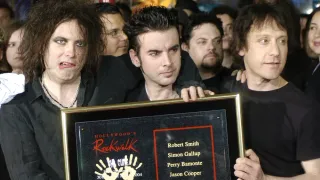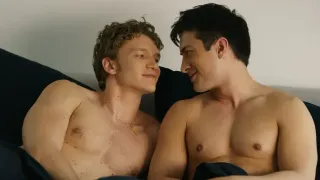December 6, 2022
'Spoiler Alert' - Jim Parsons and Ben Aldridge on Their Gay 'Love Story'
Brian Bromberger READ TIME: 9 MIN.
"Spoiler Alert," based on gay TV journalist Michael Ausiello's 2017 memoir, concerns his 14-year love affair with his photographer partner, Kit Cowan, who died of a rare neuroendocrine cancer in 2015.
While the memoir is highly recommended, the bland, conventional, and formulaic adaptation released by Focus Features is a missed opportunity to create an edgier, more daring grief drama to show how people use fictional stories to sort out pain or conflict.
Jim Parsons stars as Ausiello. Obsessed with television at an early age, he finds it a defense mechanism to deal with the trauma of being gay and the grief of his mother's death.
Gay scriptwriters David Marshall Grant (the actor best known as gay Russell in the landmark 1989 episode of TV's "thirtysomething," shown in bed with another male character after having had sex) and sex advice columnist/relationship guru Dan Savage, make the gimmicky choice of portraying Ausiello's childhood as a fantasy 1980s family sitcom complete with a phony living-room set and canned laugh track as a means of downplaying the pathos/depressing elements of the plot.
While this stylistic daydream approach works as Ausiello grows up, it winds up distancing us from the later emotional tragedy, and almost sabotages the heartbreaking climax in the deathbed scene. Director Michael Showalter, who skillfully mixed comedy and drama in the hospital soap opera "The Big Sick," falters here, so we are left with a gay tear-jerker imitation of the 1970 "Love Story."
Relationship Issues
Sally Field and Bill Irwin play Cowan's (Ben Aldridge) parents, who (stretching believability) are immediately accepting. At age 30 he finally tells them he's gay. They scold him for not trusting them sooner with the good news. Field is the mother every gay man wishes he had and invests the role with exuberance. Irwin is fine, but considering he's a great comic clown, he's criminally underused here.
Also, the middle of the film depicts a rough patch in the Ausiello/Cowan relationship; a lack of sexual desire, conflict, betrayal and infidelity which couples therapy cannot save, leading to separate lives and living quarters. There's an almost miraculous healing reunion once Cowan receives his terminal diagnosis, with little resolution of the issues that drove them apart.
After his 12-year Emmy-winning stint on CBS's "Big Bang Theory," Parsons would seem the ideal choice to play television fanatic Ausiello (complete with a huge Smurfs collection addiction), even though his That's Wonderful Production Company pitched the idea of making a movie to Ausiello.
Parsons in simpering, snarky but eventually heroic mode meets the challenge. Ausiello, as a former fat kid (FFK), has issues about his sexuality. He's scared to take off his shirt in front of Cowan, which inhibits their sex life.
Cowan is a commitment-phobe, ambivalent about monogamy. The chemistry between Parsons and Aldridge at first comes across as awkward and reluctant, but improves as the romance blossoms, thanks largely to Aldridge. He invests charisma and a winsome energy into an underwritten role (in the second half, Field has more screen time than Aldridge). It's a potentially star-making performance for him.
Gay Shorthand
In an interview with Parsons and Aldridge three weeks ago at the Ritz Carlton Hotel, when they visited San Francisco for the film's promotional screening at the Castro Theatre, both men were asked if being out gay actors was an advantage in telling this story.
"I feel my being gay wasn't the most important connection because the film is so much about loving another person and the risks that involves," Parsons commented. "However, making the film with another gay actor and lots of queer people on our creative team definitely added something... I wish I had words to describe what it brought more fully."
For Aldridge, the relationship built with Parsons as an actor helped him define his character.
"We had an email relationship, as we had never met before, me being in London and Jim in New York," said Aldridge. "We discussed our acting and shared moments about our sexuality and what they meant to us. The way we'd related to people in the past did affect what we brought to the relationship on screen. Having lots of LGBTQ people on the production team creates a shorthand, an understanding. There don't have to be rules that only gay actors should play gay characters, but those telling the story really do understand what's going on, which help guide and protect the stories."
For Parsons, from the moment Aldridge auditioned on Zoom, knew he was the one he should be working with.
"I felt I didn't have to explain myself to him, being so comfortable with him from the start," Parsons said. "There was never a moment of 'What does he mean,' and that spirit has continued for over a year now. We were getting to discover each other, doing the work that mimicked the Michael-Kit relationship. He was always surprising me, which seemed an important aspect to being a couple on camera."
Life-affirming
With the box office failure of "Bros," a gay rom-com with an all-queer cast that was heavily promoted, were they worried if LGBTQ audiences would show up for "Spoiler," especially since the film could be seen as a downer compared to the upbeat "Bros?"
Parsons didn't want to predict how well the film would do, seeing "different elements at play, but I don't feel the success or failure of both films is sexuality based in any way."
Aldridge rejected the downer label.
"I've only viewed the film once, but I was surprised with my takeaway. I didn't feel I had watched a film where someone dies, but rather two people who fall in love and all that involves. It chronicles a relationship fairly well, from the spark of discovering someone, being disarmed by someone, and how time and life can change that relationship. When you leave the theater, you don't feel weathered, but exhilarated because the film is life-affirming. You cry and are moved, marveling at life and awe that love is at the center of this film, in a way different from other queer films we've seen before, that are often centered more on struggle."
Parsons – with his own It's Wonderful Production company, which helped make the film – said it gave him the opportunity to cast people that don't often cast in roles like these, so other voices got heard.
"But I think it's more important to get executive decisions from studios on board with out voices, otherwise it will be hard to get our stories told."
The dying gay lover was a key feature in such AIDS films as "Longtime Companion" and "Jeffrey." While Parsons acknowledged that these films must have had an impact in terms of background for "Spoiler," he admitted that the rom-coms of the 1990s he grew up with, which weren't necessarily about gay people, "was what I connected more when it came to making this movie. The gay films of the 1980s and 1990s were some of the first mainstream representations of gay life which paved the way for a movie like 'Spoiler Alert.' "
Parsons also performs a tongue-in-cheek nod to a famous Shirley MacLaine hospital scene from "Terms of Endearment."
Humor in Drama
According to Parsons, humor took away some of the sting of the film's ending.
"The absurdity of the sit-com skits enabled some of the more profound moments to become more prominent, even more heartbreaking. Playing around with the structure, which we got from the book, says we're admitting the artifice and no one is trying to trick anybody, or put one over the audience, but it allows them to let their guard down and really absorb what happens."
Aldridge was conscious of not wanting to do any comic acting.
"I was more interested in allowing Michael and Kit to make each other laugh, as evidence of their playfulness, which might make the audience laugh as well," he said. "Rather than focusing on the scenes intentionally written to be comic, we were more concerned with those ones where they were enjoying each other and allowing the humor to radiate from that."
Aldridge, who came out publicly as gay in 2020, feels fortunate that stories like "Spoiler Alert" are being told now and he's glad to be a part of them.
"Part of my choice to come out publicly was that something felt misaligned," he explained. "I'd played a lot of straight, romantic parts. In my 30s, I want to play things I really understand and connect to. We're more than men that suffer with shame. There is room to celebrate the love and the joy of who we are. At its heart, 'Spoiler Alert' is two people in love. That's what I feel most proud of."
Help keep the Bay Area Reporter going in these tough times. To support local, independent, LGBTQ journalism, consider becoming a BAR member.






